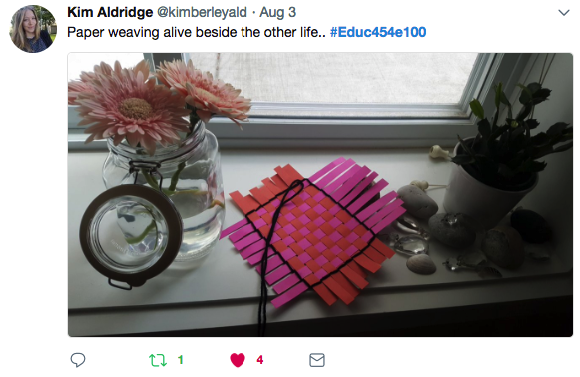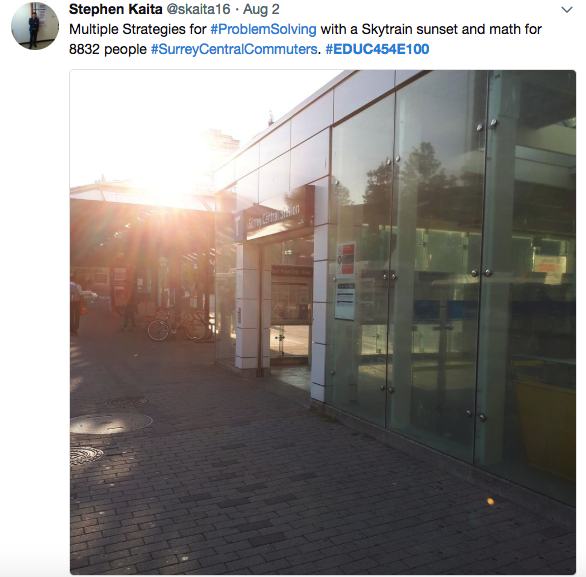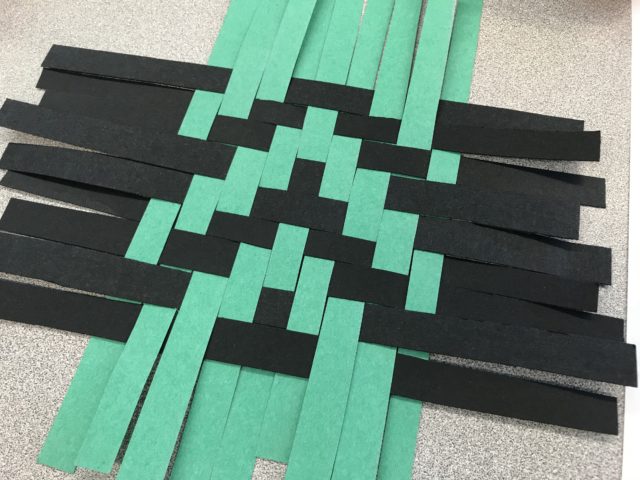Outdoor Math Adventure
#EDUC454E100 – Week 13 – August 2, 2018
Well… this is the last week of EDUC454 evening course at SFU Surrey Summer Session. I cannot not believe that our time together has ended. I also cannot believe that I am well overdue to write this blog reflection on Week 13. I do have a reason… I (successfully) moved to Prince George, BC last week soon after our class. I will be teaching at UNBC (University of Northern British Columbia) as a full time Lecture in the upcoming school year. I am really looking forward to teaching at UNBC, but moving to Prince George felt like going to first year of university all over again… except I am in my 40’s. Moreover, I did not get internet connection into my “new place” until yesterday. I am now connected. It feels good. So here I am, sitting in my apartment in Prince George… blogging… thinking about EDUC454… and imagining about the courses I am going to teach at UNBC.
When I look at the picture above… I think on the one hand that taking photos of my class is a great way to take attendance. The class is certainly not at full capacity on this last day together. There was no exam or final paper due on August 2nd that would lure (or coerce) students to come to class. I would suspect that students who are absent were motivated by getting assignments done for other courses or personal reasons. My view is that we get too preoccupied by the TASK and underwhelmed by the LEARNING experience. I don’t blame students for this phenomena because schools are designed to focus on achievement versus delving into what’s possible, taking risks, and having fun. On the other hand, when I look at the faces of students in the photo smiling above, I think about the “goods internal” to learning and the drive to learn something NEW. I appreciate this a lot because tonight’s class was only about engaging in the learning activities I facilitated (i.e. The Outdoor Math Adventure). No marks. No grades. Just learning.

I started the class with a learning activity that I acquired from the UBC Aboriginal Math K-12 Symposium. We are WEAVING. I wished that I could have delved deeper in my inquiry project from last year that explored CEDAR and harvesting cedar. I love weaving and have a high respect for those who do. I also wished that we could have had someone who is a WEAVER from the local Indigenous community to talk to us about weaving and why it is so important to Indigenous people. What are cedar baskets used for? What role do weavers have in the traditional Indigenous community? How long does it take to complete a basket, hat, or pieces of clothing? How does one create the design and how does he/she implement it? I have so many questions and would love to embed the local peoples into our learning experience. That said, this was an opportunity for my students to realize that and experience the complexities of weaving (using strips of bristol board). Different patterns. Different experiences. Students choose. Students create.

Here’s a beautiful screenshot of a Tweet of our weaving experience. Math and place. I just love it. Thank you Kim for tweeting your final product. It’s an excellent segway to our next learning activity… the YOUNGHUSBAND OUTDOOR MATH ADVENTURE. Well…. it wasn’t that adventurous. Not my wheelhouse, but there were lessons FOR ME embedded in the learning activity… in preparing for it, forming challenging questions, and estimating the use of technology and math efficacy. I was surprised how many students, if not all groups, used technology to answer the 3 BIG QUESTIONS. This goes beyond using their handheld devices as “calculators” but they were using them as “fact finders” and for “unit conversions.” I watched one group solve one problem without going outside (which was the whole point of the activity)… see picture below… I’m in the background. The point of the learning activity was to ESTIMATE space, make realistic assumptions, and hypothesize REASONABLE solutions to the problem. They were asked to use Twitter to make their learning visible and tweet out a Math Curricular Competency from BC’s New Curriculum.

Here are the questions posed to the class. Hindsight, I should have made the questions more vague. Another change I would make is to explore other spaces that we have not gone to before. I was a little wary to start roaming the Surrey Central Mall as a learning space (with mathematical calculations), but I am satisfied how each team had solved the questions and what assumptions they made. A clear demonstration that students did not come up with the same solutions because each group made different assumptions.

Here are a few sample tweets that students have posted. I was hoping for more. As I look through these tweets, I see that not all of the groups posted on Twitter… whether if they forgot the hashtag, did not tweet, or security settings. This goes to show that we should have had a mini lesson on Twitter. What I hoped for was a flow of tweets from students on their calculations and Math curricular competencies. I got some. You have to start somewhere, but I like the potential of using social media or apps like GooseChase to post pictures as a way for students to demonstrate their learning and share with others.



Luckily the groups answered the questions in a timely manner. They returned to class and each team were asked to put their calculations for each question on the board. Students engaged in MUSEUM where most team members observed each team’s solutions while one member from each team stayed back to explain what they had done during their problem solving experience. After we had the opportunity to look at the different solutions and variation of answers, students were asked to pick the MOST REASONABLE solution and explain why… THE MATH DEFENCE. This is where it got interesting and heated. Math got exciting. I loved how students rationalized what was good or bad, what was considered, and what was assumed. In the end, we’re ALL WINNERS and got candy.
We conclude with my NEW favourite learning activity. It was the first time I tried this activity, like the last one, and I was so pleased how it turned out. It is another activity I learned at the UBC Aboriginal Math K-12 Symposium. Well… I learned it from someone who learned it at the symposium the year previous. I embarked on protocol and asked an artist to use one of her images for this activity. The artist’s name is Margaret Briere. I first met Margaret in 2011 at a Pulling Together Canoe Journey. She was one of the Indigenous youth. Since then, I’ve been watching her her growth and development on social media. I could not resist asking her to be a part of this learning experience. I also asked her for her interpretation of the image, “Coming Home.” I loved the metaphor. My students were COMING HOME as they were approaching the end of this course. The learning activity involves scale, problem solving, and communication. In the end, it was an exemplar of COLLECTIVE EFFICACY. We are all in this together. Teaching and learning.
I printed the image on an 8.5″x11″ paper and subdivided it into a 5×5 grid. I wanted to ensure that all students had at least one square to scale. I liked the idea that they would be working with squares versus rectangles. That would be something I would try next time. Students were also given an 8.5″x11′ piece of paper. First, they had to make it into a square and then they selected a small square image to enlarge it. We could have used a grid. Some students folded their paper to form grid creases. Most did not. I liked that because I wanted students to use their intuition, or knowing, with respect to scale. Once enlarged and coloured in, students took their square to the front of the room to piece the image together. They had NO IDEA what the original image looked like. They had to figure it out. I loved listening to the conversations. “Maybe these pieces are the corners.” ” Is this a spindle whorl?” “I think this piece goes here.” The following set of pictures shows the emergence of pieces being added to the puzzle… the students’ collaborating, communicating, and cooperating… and the beautiful formation of Coming Home.
Thank You EDUC454E100. It’s been my pleasure to teach and learn with you.
